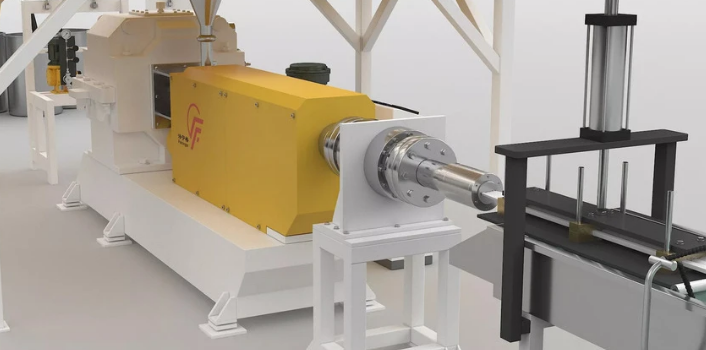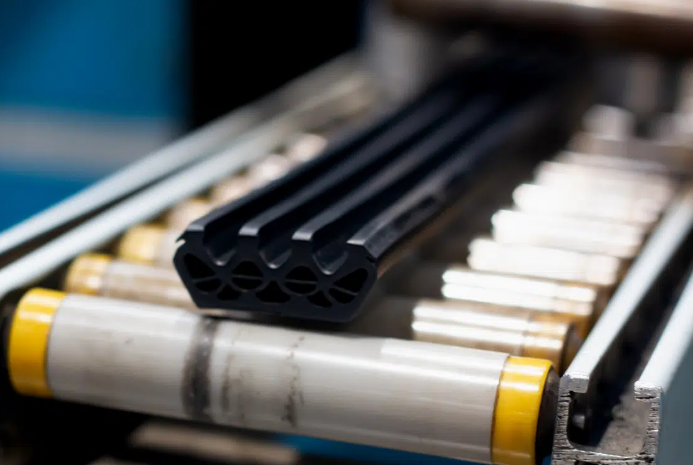The raw materials commonly used for extrusion molding include thermoplastics (e.g., PVC, HDPE), thermosetting plastics (e.g., phenolics), and metal alloys (e.g., aluminum).
Overview of Extrusion Molding
Basic Principles of Extrusion Molding
Extrusion molding is a manufacturing process that forces material through a die to create objects with a fixed, continuous cross-sectional profile. This process primarily applies to plastics and metals, where a raw material, in granular or pellet form, is fed into a heated barrel. Inside the barrel, a rotating screw pushes the material forward, melting it with heat and pressure. The molten material then passes through a die, shaping it into the desired profile. This technique is essential for its high efficiency and ability to produce long continuous products like tubes, sheets, and profiles.

The efficiency of this process depends significantly on the power of the machinery, typically ranging from 15 kW to 150 kW, impacting both operational costs and output rates. Speed of production varies with the material and the complexity of the profile, but advancements in screw design and temperature control have greatly improved overall efficiency.
The Role of Raw Materials in the Process
The selection of raw materials in extrusion molding critically influences the product’s properties, lifespan, and cost. Each material offers unique characteristics:
Polyethylene (PE), for instance, is popular for its flexibility and durability, making it suitable for products like pipes and films. It’s cost-effective, with a typical lifespan of 10-20 years.
Polyvinyl Chloride (PVC) provides rigidity and fire resistance, ideal for construction materials like window frames. PVC products can last up to 50 years, though they come at a moderate cost.
Polypropylene (PP), known for its balance of strength and flexibility, finds usage in automotive parts and containers. PP parts have a lifespan of 15-20 years and are moderately priced.
The quality of the final product heavily depends on the material’s purity and preparation before extrusion. Proper drying and mixing of the raw materials are essential to avoid defects and ensure a high-quality end product.
For more detailed information, explore Extrusion Molding on Wikipedia.
Common Plastics and Polymers in Extrusion Molding
Polyethylene (PE): Types and Properties
| Type | Properties | Applications | Cost | Lifespan | Advantages | Disadvantages |
|---|---|---|---|---|---|---|
| Low-Density PE (LDPE) | Flexible, Low strength | Packaging films, Bags | Economical | 5-10 years | Easy to process | Limited temperature resistance |
| High-Density PE (HDPE) | Rigid, Strong | Pipes, Containers | Moderate | 10-20 years | High strength-to-weight ratio | Prone to UV degradation |
Polyvinyl Chloride (PVC): Characteristics and Usage
| Properties | Applications | Cost | Lifespan | Efficiency | Advantages | Disadvantages |
|---|---|---|---|---|---|---|
| Durable, Fire-resistant | Window frames, Pipes | Moderate | Up to 50 years | High | Versatile and recyclable | Releases toxins when burned |
Polypropylene (PP) and Its Applications
| Properties | Applications | Cost | Lifespan | Efficiency | Advantages | Disadvantages |
|---|---|---|---|---|---|---|
| Balance of flexibility and strength | Automotive parts, Containers | Moderate | 15-20 years | High | Chemical resistance, lightweight | Less flexible than PE |
PE, PVC, and PP stand out as the most common polymers in extrusion molding, each offering distinct advantages and limitations. The selection of these materials significantly affects the final product’s cost, quality, and suitability for specific applications.
For more comprehensive information on these materials, visit the Extrusion Molding Materials page on Wikipedia.
Specialty Materials for Advanced Applications
High-Performance Polymers: Characteristics and Uses
High-performance polymers are engineered for demanding applications where standard plastics may not suffice. These polymers often exhibit superior properties such as high temperature resistance, exceptional strength, and chemical stability.
Polyether Ether Ketone (PEEK): Known for its excellent heat resistance and mechanical strength, PEEK operates efficiently at temperatures up to 250°C. It’s widely used in aerospace, automotive, and medical industries. While PEEK offers a lifespan that can exceed 20 years, its high cost reflects its advanced properties.
Polytetrafluoroethylene (PTFE): Renowned for its non-reactivity and low friction, PTFE is commonly used in non-stick cookware and electrical insulation. PTFE operates effectively in a temperature range from -200°C to +260°C. The cost is relatively high due to its unique properties, but it provides a long lifespan, often over 25 years.
Blended and Composite Materials: Combining Properties for Specific Needs
Blended and composite materials merge the characteristics of different polymers or combine polymers with other substances to enhance performance.
Fiberglass Reinforced Plastics (FRP): FRPs combine plastic with glass fibers, resulting in materials that offer remarkable strength and durability. They are used in automotive, marine, and construction industries. Despite higher costs compared to standard plastics, FRPs offer enhanced efficiency and longevity, typically over 30 years.
Carbon Fiber Reinforced Polymers (CFRP): CRFPs are known for their extraordinary strength-to-weight ratio. Common applications include high-performance automotive parts and aerospace components. The cost of CFRPs is among the highest in polymer materials, but they provide unmatched efficiency and a lifespan that can exceed 30 years.
Each of these specialty materials has been developed to meet specific industrial requirements, offering enhanced capabilities over traditional polymers. The choice of these materials significantly impacts the cost, efficiency, and performance of the final product.
For more information on high-performance polymers and composite materials, visit Specialty Materials in Extrusion Molding.
Material Selection Criteria for Extrusion Molding
Factors Influencing Material Choice: Durability, Flexibility, and Cost
Selecting the right material for extrusion molding involves a careful assessment of several key factors:
Durability: This refers to the material’s ability to withstand wear, pressure, or damage. For example, Polyvinyl Chloride (PVC) is chosen for its longevity, often lasting up to 50 years, making it ideal for construction materials.
Flexibility: Some applications require materials that can bend without breaking. Polyethylene (PE), known for its flexibility, is often used for products like hoses and films.
Cost: Budget constraints play a significant role in material selection. Polystyrene (PS) is a cost-effective option for disposable items, balancing lower costs with adequate performance.
The efficiency of the extrusion process also hinges on the chosen material. Materials like PE and PP are known for their high extrusion speeds, contributing to greater overall efficiency in production.

Environmental Considerations in Material Selection
Environmental impact is increasingly a critical factor in material selection:
Recyclability: Materials like PET (Polyethylene Terephthalate) are popular due to their recyclability, addressing environmental concerns.
Biodegradability: Biodegradable plastics, such as PLA (Polylactic Acid), are gaining traction in industries looking to reduce environmental footprints.
Emissions during Manufacturing: PVC, while versatile, can release harmful toxins when burned. This has led to a push for materials with lower environmental impact during production and disposal.
Choosing the right material involves balancing these factors to meet the specific needs of the product while considering economic and environmental impacts.
For more in-depth information on material selection in extrusion molding, visit the Material Selection in Extrusion Molding page on Wikipedia.




